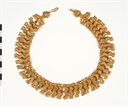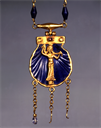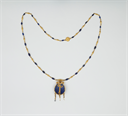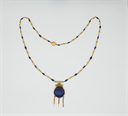Bibliography
Exposition internationale d'art Byzantin, exh. cat., Musée des Arts Décoratifs, Palais du Louvre, 28 May-9 July 1931 (Paris, 1931), 116, no. 339.
H. Peirce and R. Tyler, L'Art byzantin, Vol. 2 (Paris, 1932-34), 119, pl. 154b.
W. F. Volbach, G. Duthuit, and G. Salles, Art byzantin (Paris, 1933), 57, pl. 49, E.
L. Bréhier, La sculpture et les arts mineurs byzantins (Paris, 1936), pl. 73.1.
Bulletin of the Fogg Art Museum 10.4 (Dec. 1945): 108, fig. p.118.
The Dumbarton Oaks Research Library and Collection of Harvard University, Handbook of the Collection (Washington, D.C., 1946), 60, no. 117.
The Dumbarton Oaks Collection, Harvard University (Washington, D.C., 1955), 78-79, fig. p. 88.
M. C. Ross, Catalogue of the Byzantine and Early Mediaeval Antiquities in the Dumbarton Oaks Collection, Vol. 2, Jewelry, Enamels, and Art of the Migration Period (Washington, D.C., 1965; 2nd ed. with Addendum by S.A. Boyd and S. R. Zwirn, 2005), 18-19, no. 12, pl. 20, color pl. C.
Handbook of the Byzantine Collection (Washington, D.C., 1967), 48, no. 168.
A. Badawy, Coptic Art and Archaeology : the Art of the Christian Egyptians from the Late Antique to the Middle Ages (Cambridge, Mass., 1978), 333.
K. Weitzmann, ed., Age of Spirituality : Late Antique and Early Christian Art, Third to Seventh Century, exh. cat., The Metropolitan Museum of Art, November 19, 1977-February 12, 1978 (New York, 1979), 313-314, no. 288.
K. R. Brown, The Gold Breast Chain from the Early Byzantine Period in the Römisch-Germanisches Zentralmuseum (Monographien / Römisch-Germanisches Zentralmuseum, Forschungsinstitut für Vor- und Frühgeschichte, 4), (Mainz and Bonn, 1984), 7, fig. 4, 5.
C. Mango, "The Byzantine Collection," Apollo 119 (1984): 21-29, fig. 7.
Lexicon Iconographicum Mythologiae Classicae 2.1 (Zürich, 1984), s.v. "Aphrodite," 158, no. 89.
I. Kalavrezou, ed., Byzantine Women and their World, exh. cat., Arthur M. Sackler Museum, The Harvard University Art Museums (Cambridge, Mass. and New Haven, 2003), 18, fig. 3 (not in exhibition).
N. Metallinos, ed., Byzantium: The Guardian of Hellenism (Montreal, 2004), 115, fig. 4 (Aphrodite pendant).
G. Bühl, ed., Dumbarton Oaks: The Collections (Washington, D.C., 2008), 118, pl. p. 119.
A. D. Lazaridou, A. Cameron, H. Saradi-Mendelovici, H. Maguire, and S. Curcic, Transition to Christianity: Art of Late Antiquity, 3rd-7th Century AD, exhibition catalogue, Mouseio Vyzantino, Athens, December 7th, 2011- May 14th 2012, (New York and Athens, 2011), 45, fig. 4.
J. C. Long, "The Survival and Reception of the Classical Nude: Venus in the Middle Ages," in The Meanings of Nudity in Medieval Art ed. S.C.M. Lindquist (Farnham, Surrey, UK, England; Burlington, VT, 2012), xx, 354 p., [8] p. of plates, esp. 51, fig. 1.3.
H. C. Evans and B. Ratliff, eds., Byzantium and Islam: Age of Transition, 7th-9th Century. Metropolitan Museum of Art ed. (New York and New Haven [Conn.], 2012), 193, no. 133.
C. Cadau, Studies in Colluthus' Abduction of Helen, Mnemosyne Supplements 380, ed. D. Bright, S. McGill and J. Pucci (Leiden; Boston, 2015), 103, fig. 1-2.
Exhibition History
Paris, Musée des Arts Décoratifs, "Exposition d'art byzantin," May 28 - July 9, 1931.
Cambridge, MA, Fogg Art Museum, "A Selection of Ivories, Bronzes, Metalwork and Other Objects from the Dumbarton Oaks Collection," Nov. 15 - Dec. 31, 1945.
New York, The Metropolitan Museum of Art, "Age of Spirituality: Late Antique and Early Christian Art, Third to Seventh Century," Nov. 19, 1977 - Feb. 12, 1978.
New York. The Metropolitan Museum of Art. "Byzantium and Islam: Age of Transition," March 14–July 8, 2012.
Washington, DC. Dumbarton Oaks, 75 Years/75 Objects: Celebrating 75 Years of the Dumbarton Oaks Museum, September 8, 2015 - May 22, 2016.












